Looking at Mick Again; Demilitarising Michael Collins
Published in 20th-century / Contemporary History, Features, Issue 3 (Autumn 1995), Revolutionary Period 1912-23, Volume 3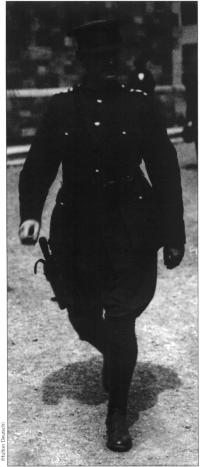 But such is Collins’ continued celebrity that images of him are not confined to the illustrative plates of biographies and histories relating to his life and times. If one wanders along Westmoreland Street or Stephen’s Green in Dublin it is possible to buy reproductions of some of the more famous photo-journalism of the revolutionary period. Amongst the various photographs of British military round ups in Dublin, Black and Tans touring the countryside on their Crossley tenders and the Four Courts billowing smoke and its documentary debris after its capture at the beginning of the civil war, it is the various portraiture of Michael Collins which continues to secure the largest sales. Not far away in the trendy poster shops of Temple Bar one can see a resplendent General Michael Collins hanging side by side with Kurt Cobain, and other, altogether more modern icons. In a society which is uncomfortable with so many of the ideals and values of the revolution with its attendant violence, it is interesting to note how easily these images and in particular Collins’ countenance find an apparently ambivalent market and market place.
But such is Collins’ continued celebrity that images of him are not confined to the illustrative plates of biographies and histories relating to his life and times. If one wanders along Westmoreland Street or Stephen’s Green in Dublin it is possible to buy reproductions of some of the more famous photo-journalism of the revolutionary period. Amongst the various photographs of British military round ups in Dublin, Black and Tans touring the countryside on their Crossley tenders and the Four Courts billowing smoke and its documentary debris after its capture at the beginning of the civil war, it is the various portraiture of Michael Collins which continues to secure the largest sales. Not far away in the trendy poster shops of Temple Bar one can see a resplendent General Michael Collins hanging side by side with Kurt Cobain, and other, altogether more modern icons. In a society which is uncomfortable with so many of the ideals and values of the revolution with its attendant violence, it is interesting to note how easily these images and in particular Collins’ countenance find an apparently ambivalent market and market place.
Enduring image
By any estimation Collins’ reputation and his image have proved remarkably enduring. It is fair to make the assertion that Collins probably represents the only political/military leader from the period of the First World War and its immediate aftermath to retain any widespread popular appeal in Europe. That appeal not only manifests itself in the photographs which are on sale on Dublin streets, and on display in any number of public, and presumably, private houses. It is also to be discerned in the annual attendance of hundreds of people who gather to remember him on the anniversary of his death at Béal na mBlath: the desolate valley in west Cork where Collins was killed on 22 August 1922. Collins still commands a following and a profound interest as the nine full length biographies and seven other books on aspects of his life and the circumstances of his death bear mute testament to.
As with all politicians and military leaders visual projection is crucial: and in time of war the importance is magnified. In the case of Collins the visual image is of heightened influence on our reading of him. Despite the sustained interest in his life and iconic public image, Collins did not bequeath a readily identifiable or accessible ideology. That is not to say it did not exist. But in his short, hectic, military and political lives he had little time or opportunity to develop and set forth a detailed ideological agenda for public digestion: and beyond any understanding of the public Collins there is the monumental task of unpicking the multifarious strands of his secret political life. A highly edited selection of some of his speeches and writings was published posthumously
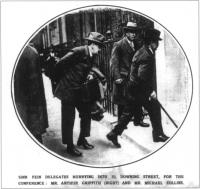
(Illustrated London News Picture Library)
in a slim volume, The Path to Freedom (Dublin 1923), but biographers have not offered us a rigorous analysis of them nor of the political thinking evidenced in some of his private writings shortly before his death. Historians, meanwhile, with one or two brave exceptions, have preferred not to roll up their sleeves and delve into the barrel of eels which is Collins’ secret and above all contradictory revolutionary career.
Timeless political figure
Whereas de Valera’s vision of Ireland is tangible and recognisable: rural, Roman Catholic, unified, introverted and Gaelic, Collins’ Ireland at the time of his death was a promise located in the rhetoric of his speeches and public utterences. There it has remained unrealised, unidentifiable and unchallenged. This perhaps begins to explain the enduring appeal of Collins and to elucidate the importance of his visual representation. With the received Collins there is no readily identifiable ideological agenda or set of values to react against or to reject. If you accept the idea that Collins was the apotheosis of the pragmatic politician then you create a timeless political figure ever appealing to any generation and any set of circumstances. Without a corpus of political ideas or their material manifestation our reading and interpretation of Collins has to be derived from biography and also, given Collins’ undeniable photogenic quality, his visual presentation.
The secret of Collins visual appeal, apart from its youth and vigour, is its romantic quality—Collins as soldier, or more accurately Collins as warrior. This in part explains the popularity of photographs and the stylised portraiture depicting Collins in his general’s uniform on reproductions, posters and the dust-jackets of most of the biographies of which he is the subject. Collins was of course a soldier and arguably the most important individual soldier in the campaign against the British military in Ireland. But the Collins of 1919-21, was a very different type of soldier to the one so often depicted striding across the parade ground of Portobello Barracks with his revolver slung loosely from his sam brown belt. Implicit in this image—and others of its type—is Collins the gunman and as such the image is misleading, while the power of its composition adds to the potency of the deception. One cannot help but suspect that the popularity of the image of Collins in his general’s uniform has little to do with its somewhat unpalatable context, the Irish civil war. In what other country does one find a civil war general eulogised like Collins: and by the linear descendents of both sides? Witness Liam O’Murchu’s televisual celebration of Collins on his Life Lines programme (RTE) last April. Could it really be that the civil war is an irrelevance in contemporary Ireland? Perhaps it is more comfortable to ignore Collins’ role in that fratricidal conflict and to project instead this warrior image on to the war against the British. There are elements of fantasy and denial in the militarist projection of Collins which are mirrored in biographical treatments. While the exploits of Collins and his hand picked assassins, the Squad, are repeatedly treated in minute detail by biographers, the much better documented war against the anti-Treaty IRA during the civil war (his role as a civil war commander is arguably the best documented aspect of his public life) is continually treated with decidedly less rigour.
Paper-shuffling soldier
Collins was an administrator first and foremost. With unprecedented success he organised the campaign against the British intelligence system and while undeniably a brilliant soldier, he was a paper-shuffling soldier and not the gunman implicit in some of the more martial representations of him. Indeed Collins’ lack of combat experience probably cost him his life at Béal na mBlath which was his first real military engagement since his involvement in the 1916 Rising. This is not to detract from his achievements either as the mastermind behind the IRA counter-espionage campaign or his later prosecution of the war against the anti-Treaty IRA in the early weeks of the civil war. It is merely to challenge and to reinterpret an all-too-readily accepted image. It is also to begin to shift the focus of attention away from Collins the militarist, the obsession of so many biographers, towards a better understanding of Collins the administrator, politician, and ultimately state-builder.
Pulp fiction
These areas, and the long-term significance of Collins, have received scant attention in much of the literature produced on him. Only in Ronan Fanning’s work on the Department of Finance do we get a substantial indication of Collins’ seminal contribution to the formation of the new state machine and his ability as a minister and prime minister. But like the seldom published photograph of Collins at his departmental desk, the Michael Collins of the Department of Finance does not have the same appeal as Collins the gunman. The romantic/militarist portrayal of Collins has remained the dominant and popular image-myth and has been bolstered, if not spawned, by the populist, almost pulp fiction, biographical genre which has grown around Collins.
From the first major biography of Collins by Piaras Beaslaí (1926) to the most recent and substantial work on him by Tim Pat Coogan (1990), biographers have adopted a narrative rather than an analytical approach. Collins’ life story, rather like his personality and personable figure, has proved irresistible to biographer and reader alike: the bright but poor boy from west Cork who returned from England to outwit and defeat the Saxon foe; leader of the first independent government and army in Irish history at just thirty-one years of age; his death at the moment of the new state’s inception at the height of his powers, political, military, and intellectual. Perpetrated by his fellow countrymen and countymen, is an event worthy of the greatest of Greek tragedies. And with the main protagonist having the good manners to possess matinee-idol good looks, Collins’ life story is the literary equivalent of the rags to riches story in the biographical canon of Irish nationalist heroes.
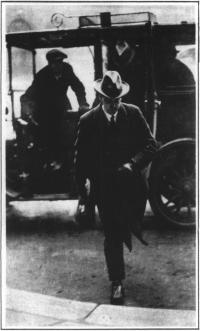
The head of the Irish Provisional Government enters Dublin Castle: Mr Michael Collins arriving at the Privy Council chamber.(illustrated London News Picture Library)
Aware of potential of photographic and filmic images
The biographical interpretation of Collins has influenced and fed the visual representation and in turn they have fed off each other to reinforce the romantic myth of the Collins of popular fiction and posters. But to what extent is our choice of image arbitrary? Collins’ political and military lives were spectacular in every way, including their brevity, giving us a limited collection of images from which to choose. Indeed that short public political life was suspended during the war against the British and only begun again when he was selected in October 1921 as a Sinn Féin plenipotentiary to attend the Treaty negotiations in London. Collins was acutely aware of both the danger and the potential of his own photographic and filmic image. As Minister of Finance in 1919, he ensured that the issuing of the first Dáil loan would be captured on camera—and ensured in the process that he would have the starring role in the production. The escalation of hostilities precluded the film’s use as propaganda in Ireland, but Collins’ initiative was the first instance of Sinn Féin using film as a medium for its political message. Again, shortly after the outbreak of the civil war in June 1922, Collins found it necessary to bring to the attention of the Minister of Propaganda, Desmond FitzGerald, the advantages of using cinema as a means of getting the pro-Treaty war message over to a larger and more international audience.
Aside from propaganda there were pragmatic reasons why Collins should be extraordinarily self-conscious of his photographic image and the use of film. During the war against the British, and right up until the early Treaty negotiations which made his concealment impossible, he was determined not to let the British have up-to-date photographs of him. There are several examples in group photographs—at Tom Barry’s wedding in August 1921 and even at Hans Place soon after the Irish plenipotentiaries had arrived in London for instance—of Collins ensuring that when photographs were being taken his head would be askew, thus depriving the viewer of an clear
and up-to-date portrait.
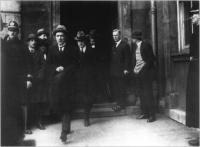
Kevin O’Higgins and Michael Collins leaving Dublin Castle on 16 January 1922 after the transfer of Power.(Hulton Deutsch)
Collins applied the same meticulous care to his photographic presentation as he did to every other aspect of his revolutionary activities. He seldom posed for press photographers, preferring instead to rush past photo-opportunities. Consequently we are provided with a multiplicity of pictures of Collins rushing in and out of 10 Downing street during the Treaty negotiations, or into University College Dublin at Earlsford Terrace during the Treaty debates and into the Mansion House in Dublin to attend pro-Treaty government meetings. During the last months of his life there was no busier man in Ireland than Collins. However, by ignoring photo-calls Collins ensured that the photographs which appeared in the press were those of him in movement, if not full-flight.
These photographs might properly be interpreted as wholly coincidental and opportunist. But a
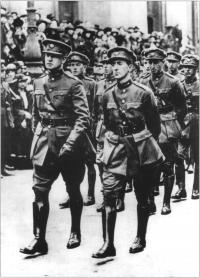
Collins at Arthur Griffith’s funeral.
(illustrated London News Picture Library)
case can be made that Collins was again controlling his image by rushing past the awaiting camera, thus conveying the image of himself as being Sinn Féin’s dynamic man of action, frantically preoccupied with his political work, the creation of a viable independent Irish state.
‘The Castle has fallen!’
On 16 January 1922, the Provisional Government led by Collins, took over Dublin Castle, the seat and symbol of British rule in Ireland for centuries, from Lord FitzAlan, the last British Lord Lieutenant. Collins once again employed the tactic of seeming to ignore the world’s press representatives and the awaiting crowds who had gathered in snow to witness the occasion. The handing over of Dublin Castle represented, physically and symbolically, the end of British domination in Ireland. For many nationalists it was the epoch-marking event in the long struggle against British rule. Batt O’Connor, a pro-Treaty Sinn Féiner and associate of Collins turned up to witness the event and recorded his emotions in a letter to his sister then living in the United States:
I witnessed the greatest event in all my life the day I stood amongst a crowd of sightseers at Dublin Castle and beheld Michael Collins accompanied by his other Ministers drive in to [sic] the Upper Castle Yard in their swell Autos to take the surrender of Dublin Castle. I wonder can you picture my feelings, joy and gratification in seeing the man above all others who laid the plans to break the power of this same castle, politely walk in and take over its power and all it stood for. No matter what ever [sic] may become of me now and no matter what I have mislaid and suffered…I am repaid a thousand times over to witness what I saw taking place that never-to-be-forgotten day at Dublin Castle. As Michael stepped out of the door of the Castle after finishing the job he stepped into his car with three more ministers. He beheld me in the crowd and beckoned me over to the car, opened the door, shook my hand and insisted that I should sit beside him and amongst thunders of cheers our cars drove out through the multitude.
The magnitude and drama of the moment was not lost on Collins either. When he returned to the Dáil cabinet shortly afterwards he greeted Arthur Griffith with the words ‘The Castle has fallen!’ However, instead of representing the culmination of the Irish nationalist struggle against Britain, and indeed Collins’ own personal war against the Castle, with any conventional image, he and his ministers hastened into the waiting cars without pausing and sped away to the Mansion House. On film, moving and still, Collins ensured that the most symbolic of the events which marked the transfer of British power into native Irish hands would be marked by a series of pictures of both he and his ministers rushing into the back of an awaiting state car. But the significance and propaganda value of both the event and the image were not lost on any super subtle politician of Collins’ complexity: he obtained exactly the image he desired—one of urgency, movement and workmanlike progress toward the establishment of the independent autonomous Irish Free State.
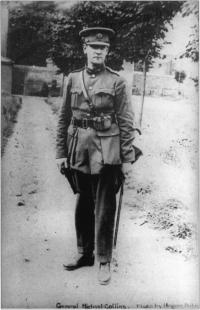 Warrior myth
Warrior myth
Photographic and the filmic images have to be, like any other source, handled with great care. The chosen image of a person or an event has to be interpreted because it is open to manipulation not only by the person pointing the camera, but also by the subject and even by the viewer Collins is a particularly difficult subject to represent visually. He understood fully his visual potential and exerted considerable control over that image. If we are too easily seduced by the romantic/militarist image of Collins it is because we are buying too readily into an image he helped to construct and which has been perpetuated in biography in pursuit of ‘the good story’. In the midst of the civil war fought on the issue of governmental legitimacy in Ireland, it was crucial to pro-Treaty propaganda to broadcast—at home and abroad—the image of ‘General Michael Collins, Commander-in-Chief of the National Army’, in the uniform of a regular and conventional army. It was a role and image he evidently enjoyed, but from a remove of nearly three-quarters of a century it is all too easy to see only the uniform, the gun, and collectively the warrior myth. We miss or ignore the other side of that brilliant revolutionary career, the political and, more especially, the administrative. Collins wore his general’s uniform for just six weeks and made relatively few public appearances in it. On each of these occasions he ensured the image he desired was the one reproduced. Storming toward the camera at Portobello Barracks. With cane-cum-swagger stick at Templemore Barracks, or at the head of a phalanx of his General Staff and senior officers at Arthur Griffith’s funeral. While it would be facile to deny the importance of his military career and its undoubted success, it is perhaps time to start looking beyond this rather simplistic, guileless visual and literary interpretation and to start to think hard about the less glamorous but perhaps far more important and in the long-term influential Michael Collins: the administrator and the state builder. But would posters of Collins behind his ministerial desk sell on Westmoreland street?
John Regan is the Irish Government’s Senior Scholar in the History and Culture of Ireland at Hertford College, Oxford.
Further reading:
M. Collins, The Path to Freedom (Cork and Dublin 1995).
R. Fanning, The Department of Finance (Dublin 1978).
F. O’Connor, The Big Fellow (Dublin 1994).
















